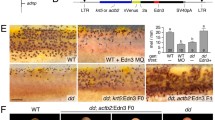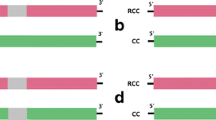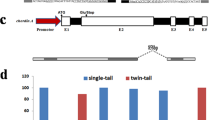Abstract
In the medaka fish (Oryzias latipes) many mutants for body color have been isolated. A typical example is the recessive oculocutaneous albino mutant i, which has amelanotic skin and red-colored eyes with no tyrosinase activity. To cast light on the molecular basis of the albino mechanism, we performed Southern blot analysis of genomic DNA from the mutant with an authentic tyrosinase gene probe; the results demonstrate that an extra 1.9 kb fragment is present inside the first exon. The insertion is responsible for the oculocutaneous albinism. About 80 copies of this fragment are present in the genomes of albino-i and wild-type fish; these repeated sequences are here designated Tol1 elements and the particular element found in the tyrosinase gene of albino-i is denoted Tol1-tyr. The nucleotide sequence of Tol1-tyr shows that the fragment (i) carries terminal inverted repeats of 14 bp, and (ii) is flanked by duplicated 8 by segments of the host chromosome. These are properties of DNA-mediated transposable elements. Comparison of the nucleotide sequence of Tol1-tyr with other sequences in DNA databases, with special attention to sequences of transposable elements known to date, did not reveal any similarity. Thus, Tol1 constitutes a hitherto unknown family of DNA transposable elements.
Similar content being viewed by others
References
Beermann F, Ruppert S, Hummler E, Bosch FX, Müller G, Ruther U, Schütz G (1990) Rescue of the albino phenotype by introduction of a functional tyrosinase gene into mice. EMBO J 9:2819–2826
Finnegan DJ (1985) Transposable elements in eukaryotes. Int Rev Cytol 93:281–326
Henikoff S (1992) Detection of Caenorhabditis transposon homologs in diverse organisms. New Biologist 4:382–388
Howe M, Berg DE (1989) Mobile DNA. Amer Soc Microbiol, Washington DC
Inagaki H, Bessho Y, Koga A, Hori H (1994) Expression of the tyrosinase-encoding gene in a colorless melanophore mutant of the medaka fish, Oryzias latipes. Gene 150:319–324
Korner A, Pawelek J (1982) Mammalian tyrosinase catalyzes three reactions in the biosynthesis of melanin. Science 217:1163–1165
Radice AD, Bugaj B, Fitch DHA, Emmons SW (1994) Wide spread occurrence of the Tc1 transposon family: Tc1-like transposons from teleost fish. Mol Gen Genet 244:606–612
Rosenzweig B, Liao LW, Hirsh D (1983a) Sequence of the C. elegans transposable element Tc1. Nucleic Acids Res 11:4201–4209
Rosenzweig B, Liao LW, Hirsh D (1983b) Target sequences for the C. elegans transposable element Tc1. Nucleic Acids Res 11:7137–7140
Saiki RK, Gelfand DH, Stoffel S, Scharf SJ, Higuchi R, Horn GT, Mullis KB, Ehrlich HA (1988) Pimer-directed enzymatic amplification of DNA with a thermostable DNA polymerase. Science 239:487–491
Sambrook J, Fritsch EF, Maniatis T (1989) Molecular cloning: a laboratory manual (2nd edn). Cold Spring Harbor Laboratory Press, Cold Spring Harbor, New York
Sanger F, Nicklen S, Coulson AR (1977) DNA sequencing with chainterminating inhibitors. Proc Natl Acad Sci USA 74:5463–5467
Takeda A, Tomita Y, Matsunaga J, Tagami H, Shibahara S (1990) Molecular basis of tyrosinase-negative oculocutaneous albinism. J Biol Chem 265:17792–17797
Tanaka S, Yamamoto H, Takeuchi S, Takeuchi T (1990) Melanization in albino mice transformed by introducing cloned mouse tyrosinase gene. Development 108:223–227
Tomita H (1975) Mutant genes in the medaka. In: Yamamoto T (ed) Medaka (Killifish). Biology and strains. Yugakusha, Tokyo, pp 251–272
Yokoyama T, Silversides DW, Waymire KG, Kwon BS, Takeuchi T, Overbeek PA (1990) Conserved cysteine to serine mutation in tyrosinase is responsible for the classical albino mutation in laboratory mice. Nucleic Acids Res 18:7293–7298
Author information
Authors and Affiliations
Additional information
Communicated by J. A. Campos-Ortega
Rights and permissions
About this article
Cite this article
Koga, A., Inagaki, H., Bessho, Y. et al. Insertion of a novel transposable element in the tyrosinase gene is responsible for an albino mutation in the medaka fish, Oryzias latipes . Molec. Gen. Genet. 249, 400–405 (1995). https://doi.org/10.1007/BF00287101
Received:
Accepted:
Issue Date:
DOI: https://doi.org/10.1007/BF00287101




